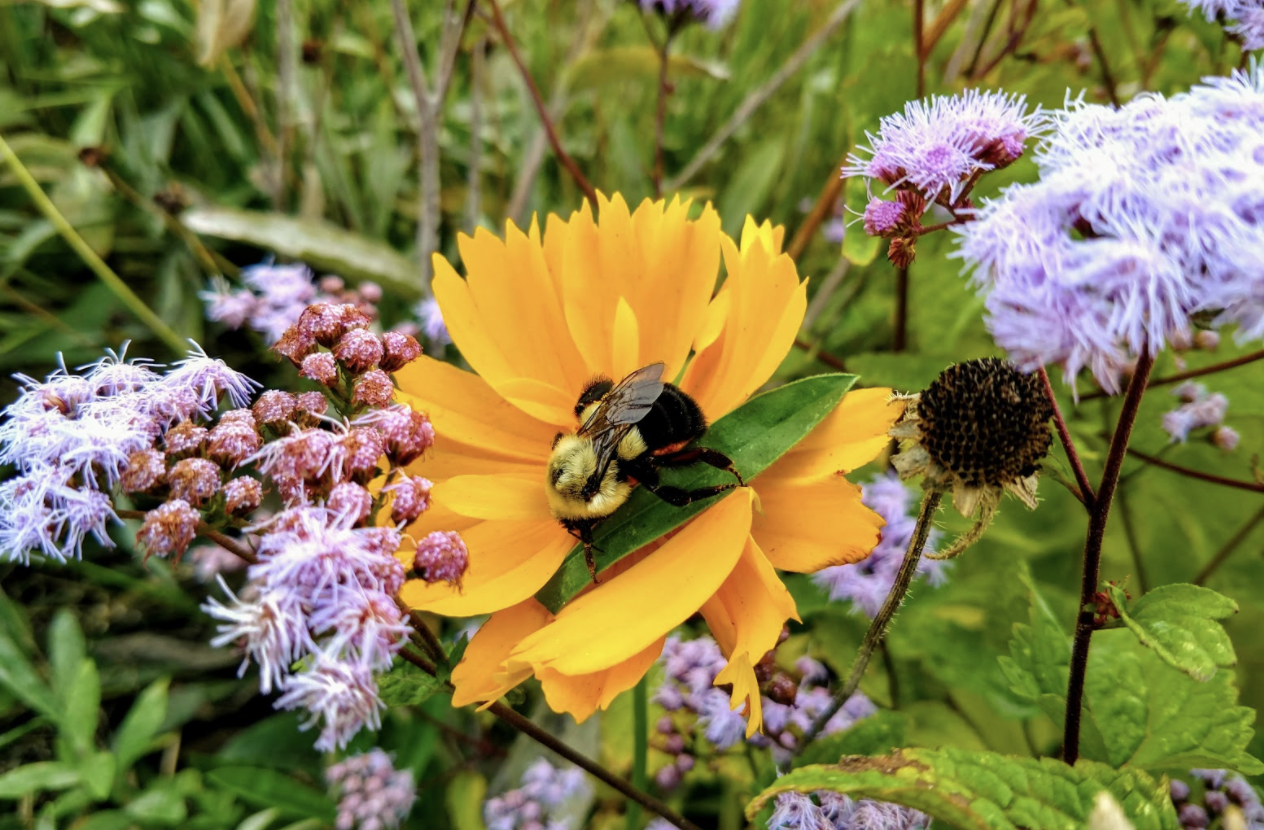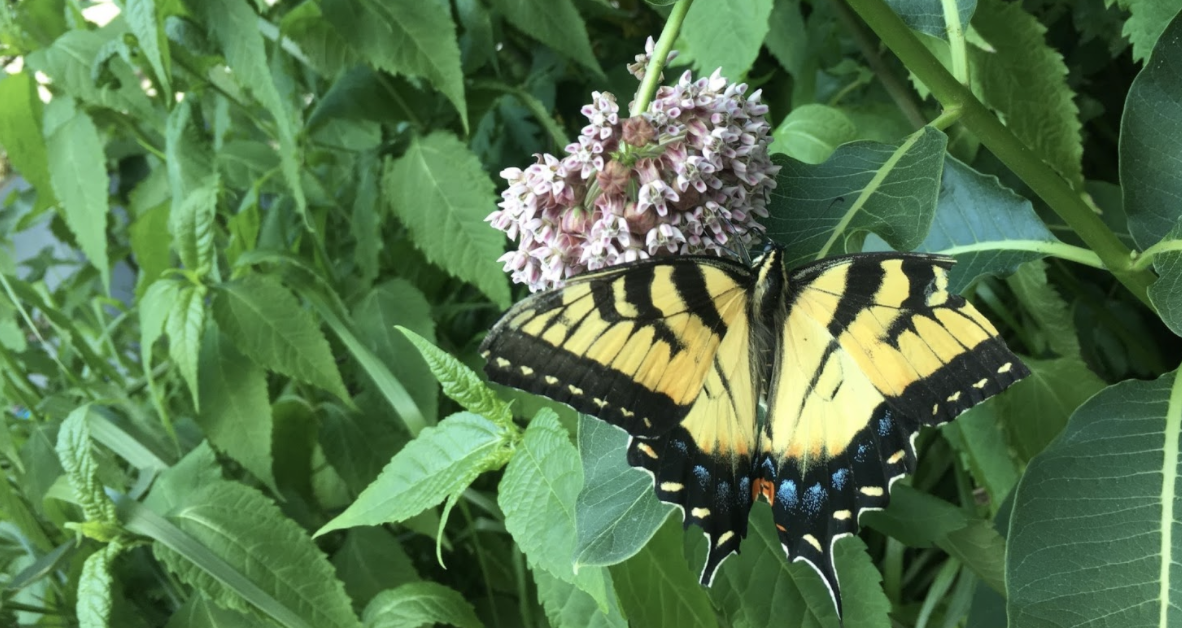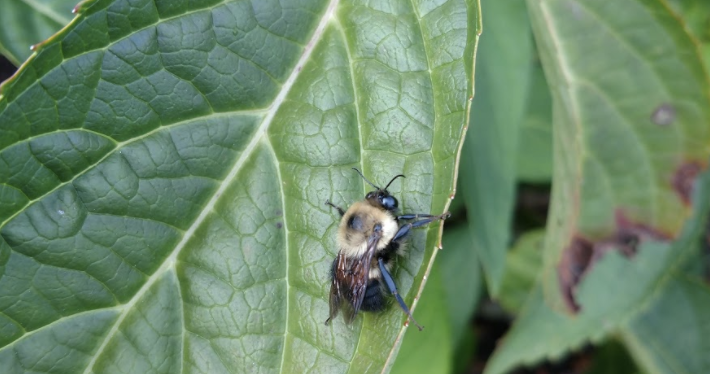Supporting our Native Pollinators at home and on The Greenway
Written by Tori Hiney, Ecological Health Care Horticulturist
Spring is in the air and on The Greenway as we celebrate the 50th Anniversary of Earth Day! The park is coming back to life after our mild winter, blooms abound, and we are starting to see our polli-neighbors emerge.
In case you need a reminder, we at the Conservancy absolutely adore our pollinators on The Greenway. In 2019, we became the first public park in Boston to install three hives of Italian honeybees (Apis mellifera liqustica) that now call the park home.
While we love our newest winged residents and their quirky behavior, The Greenway relies on a complex network of additional pollinators and beneficial insects as well, including our native species. In particular, we’re focusing today on our New England native bees. These bees in particular heavily rely on the park ecosystem for food and shelter, and equally the system very much depends on them to facilitate plant reproduction. As our park continues to gain its ecological foothold, Conservancy staff and dedicated horticulture volunteers take our responsibility seriously to observe and adapt our practices to fit the needs of the park rather than dictating or projecting our societal preferences. We do this to protect those very vital native species who call The Greenway home and they in turn keep the park happy, healthy, and beautiful.

We think about The Greenway and the city as part of a broad ecosystem in which we and pollinators all exist together. Just think about what you love and value about living in Boston (or wherever you may call home). Let’s take me, for example. Personally, I love that I can ride my bike to work, that I can see the grocery store from my front door, and that during the summer I can stroll to a locally sourced farmers market. I love that there are a thousand and one different places I can eat out (and that a lot of those places have vegetarian options) and that my apartment has a roof and a deadbolt. We all value convenience, fairly specific food, shelter, and security.
Our native pollinators value the exact same things. Just like me, they prefer not to travel more than a few hundred feet to do their grocery shopping (foraging) and have specific diet restrictions. Just like me they don’t want to come home from grocery shopping to find that their home has been ransacked, and put a lot of thought into where they’re going to live (nest) and generally do not settle for a home without a roof. Because we all know what New England winters can be like.
So all of these concepts together are what we consider on The Greenway and are how you can create a successful ecosystem for bees and others at your home too! At the Conservancy, we attract pollinators to the park through our diverse range of native plants, entice them to stay with our cute pollinator houses, and protect them over the winter by leaving leaves and other natural debris for them to use as shelter. In the park you can imagine each area is its own little neighborhood with a shopping center, gluten free bagel shop, and residents who moved in because they liked the offerings. If you build it they will come! Well it’s a thriving mini metropolis down here!

If it sounds hard to do on your own, it’s not, I promise. Here are a few things you can do right now to keep your little neighborhood on the up and up.
- Avoid cutting last year’s perennials lower than 8”. Remember that you have adorable little pollinators sheltering in that old growth who are not expecting you to chop down their shelter and are very likely not equipped to face the New England weather quite yet. If your gardening includes cut backs, a spunky fun way to maintain pollinator homes is to bunch up the cuttings into little bails, like corn stalks, and leave them vertically leaning somewhere in your yard.
- Minimize disturbance around the base of your plants, especially your bunch or ornamental grasses. We are all accustomed to trimming back those floppy blades the first chance we get, but resist the urge if possible! You may find you have a hibernating queen bumble bee overwintering. While it might seem like, “NBD, just one bee”, it’s in fact hundreds of bees lives she holds as a queen. The entire fate of her colony resides with her and she just made it through winter, alone in New England. Cut the girl a break!
- Leave the leaves! Avoid raking or leaf blowing as a means to remove material from your garden or try to cut back where you remove material and reduce what you remove. This is not only habitat for pollinators and beneficial insects, but they help to build the soil food web as they break down and feed all of those good critters in the soil. But that’s a whole other topic for another blog!

Spring is a very delicate time for our native pollinators. Just like us, they’re true New Englanders in spirit. Half the population is busting out of the house in shorts and a tank top the second the temperature looks like it might reach 50 degrees, while the other half is not making an appearance until temperatures are reliably in the 70’s. So while you should always be observant and be curious, be patient and try not to be disruptive.
For those of you who can safely visit The Greenway, we remind you to practice appropriate physical distancing, including wearing a face covering over your mouth and nose when in public and to stay home from 9p to 6a each day. For those further afield this Earth Day, we invite you to learn more about your native pollinators digitally, and to look in your own backyard or neighborhood for signs of spring as you #BringTheGreenwayHome. Share what you find online by tagging our social media channels!

